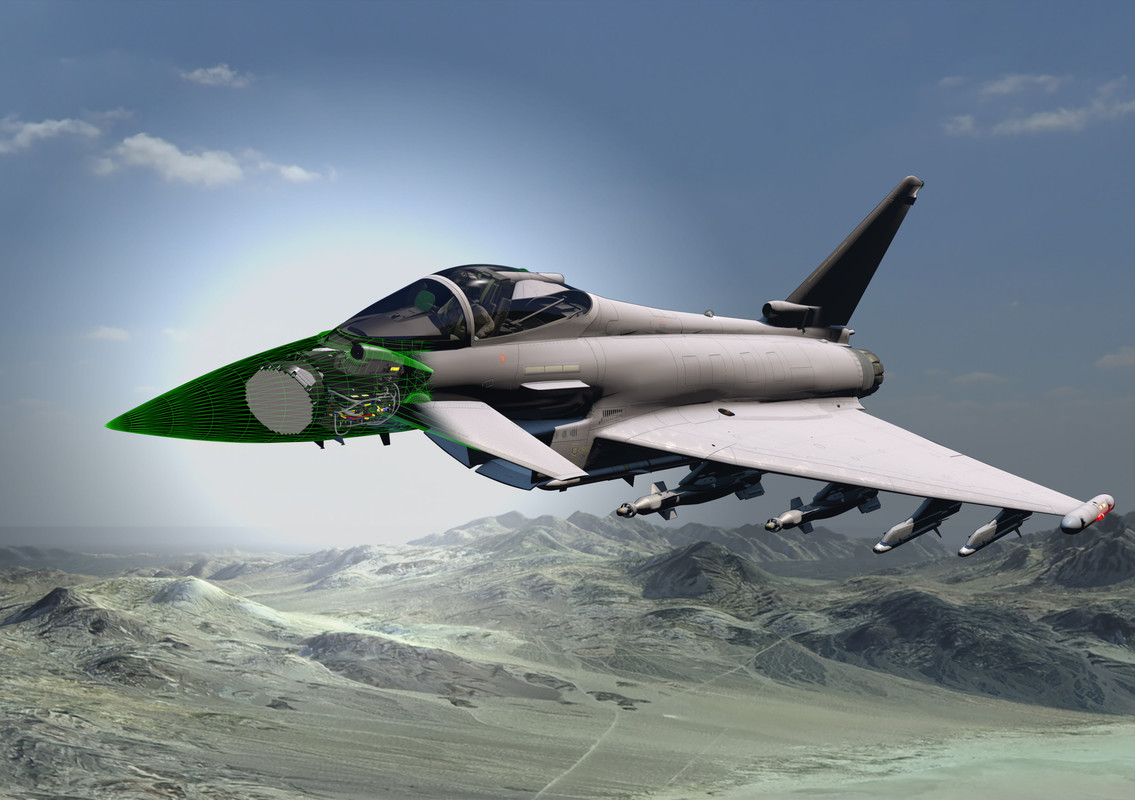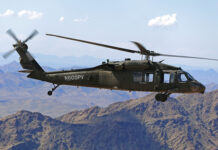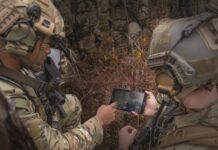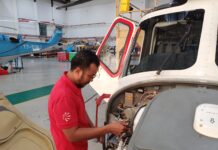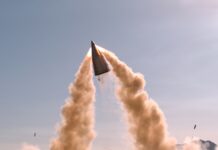All new generation fighters are produced with the Active Electronically Scanned Array (AESA) radar, and many already in-service fighters have been, or are being retrofitted with this system.
Industry on both sides of the Atlantic have invested heavily on the AESA fire control radar for the latest larger combat aircraft. They have done so due to the main advantages in these systems, including the greater control of a beam by using hundreds of solid-state transmit and receive modules (TRMs) rather than a large single unit, alongside the enabling of aircrews to employ air-to-air and air-to-ground modes simultaneously. There is also the ability to track multiple targets while continuing to scan rapidly large volumes of airspace for additional threats, as well as the graceful degradation and therefore higher availability and efficiency compared to conventional mechanically scanned radars. AESA radars are not only used for air-to-air and air-to-ground operations, but also for Electronic Warfare (EW), including Electronic Support Measures (ESM), Electronic Attack (AE) and Electronic Support (ES). While in the past, gallium arsenide (GaAs) was the common latest generation TRM-applied technology, more recently the higher efficiency and more powerful gallium nitride (GaN) is applied to the airborne fire control radar and the trend is a larger diffusion.

Main US AESA Radar Developments
Raytheon has been pioneering the AESA technology, being the first company to provide such a capability to a US combat aircraft, having provided the AN/APG-63(V)2 as a major upgrade for 18 US Air Force Boeing F-15C aircraft. It combined the proven AN/APG-63(V)1 ‘back end’ – which represented a significant improvement in terms of performance and reliability compared to the original model thanks to the adoption of the first airborne radar software programmable signal processor – with a new AESA antenna. The latest AN/APG-63(V)3 radar version builds upon the previous (V)2 model technology and the hardware advance of the F/A-18 E/F Super Hornet’s APG-79 AESA radar. In addition to the upgrading of the US F-15 C/Ds, the (V)3 radar has also found export applications, having being deployed in Singapore’s new-build F-15SG and Saudi Arabia’s new F-15SA aircraft.

In January 2011, the US Air Force launched flight test activities for the F-15E Radar Modernisation Programme (RMP) to replace the F-15E legacy APG-70 mechanically scanned radar with the AESA-equipped APG-82(V)1. According to US Defense Department (DoD) documentation, the RMP is designed to expand mission employment capabilities, including near-simultaneous interleaving of selected air-to-air and air-to-ground functions, enhanced air-to-air and air-to-ground ground classified combat identification, longer range air-to-air target detection and enhanced track capabilities, alongside longer range and higher resolution air-to-ground radar mapping.

Photo: Raytheon
The APG-82(V)1 antenna and power supply come from the (V)3 programme, while the radar receiver/exciter and the Common Integrated Sensor Processor are based on the F/A-18E/F AESA system. In addition to the upgraded F-15E, the APG-82 has been integrated into the new F-15EX model, and is used on the Israeli Defence Forces/Air Force F-15I and the Japan Air Self-Defence Force’s F-15J upgrade. In June 2021, the USAF awarded Raytheon a study contract for unspecified upgrades to the F-15EX‘s APG-82(V)1 to be completed in September 2021. The Raytheon APG-79 radar family became the leading and first programme for the AESA-based gallium nitride (GaN) technology fire-control radar. A derivative of the APG-79 radar family, the APG-79(V)4 AESA radar version with GaN TRMs is being procured to replace the APG-73 on board the US Marine Corps F/A-18 Hornets with the first flight of pre-production radar hardware conducted last May.

Further Exports
In June 2021, Jordan signed a letter of offer and acceptance (LOA) covering the procurement of eight F-16 C/D Block 70 aircraft, becoming the newest customer of the latest version of the Lockheed Martin combat aircraft. The Block 70/72 and similar F-16V upgrade package features an advanced avionics centred on the new APG-83 radar, a modernised cockpit and avionics suite, advanced weapons, conformal fuel tanks, improved engine performance and service-life extended airframe. The Northrop Grumman APG-83 Scalable Agile Beam Radar (SABR) provides 4th generation F-16s with 5th generation fighter radar capabilities by leveraging hardware and software commonality with the F-22’s APG-77 and F-35’s APG-81 AESA radars.

Building on Northrop Grumman’s 40-year legacy of producing radars for the F-16, the APG-83 SABR integrates within the F-16’s current structural, power and cooling constraints without Group A aircraft modification. Production of the APG-83 is underway for a worldwide F-16 upgrade and new aircraft production programmes, as well as having recently completed installation on the United States Air National Guard F-16s to meet a US Northern Command Joint Emergent Operational Need (JEON) for homeland defence. The APG-83 is an official programme of record for equipping both the US Air Force’s active, Guard and Reserve components. The SABR-based APG-83 AESA radar provides autonomous, all-environmental stand-off precision targeting, greater target detection and tracking range, alongside interleaved mode for greater situational awareness, maritime modes and three to five times greater reliability and availability compared to current fire control radar systems. The SABR features a larger area, high definition, synthetic aperture radar capability called ‘Big SAR’, according to Northrop Grumman. This mode provides pilots with unprecedented large target area details in a single image on the cockpit digital map displays that can be tailored with slew and zoom features. The advanced capability enables greater situational awareness and flexibility, according to the manufacturer, alongside quicker all-weather targeting. The system’s advanced processing and proprietary algorithms, automatically scan entire SAR maps, precisely locating and classifying targets of interest, thereby greatly reducing pilot workload, according to Northrop Grumman.
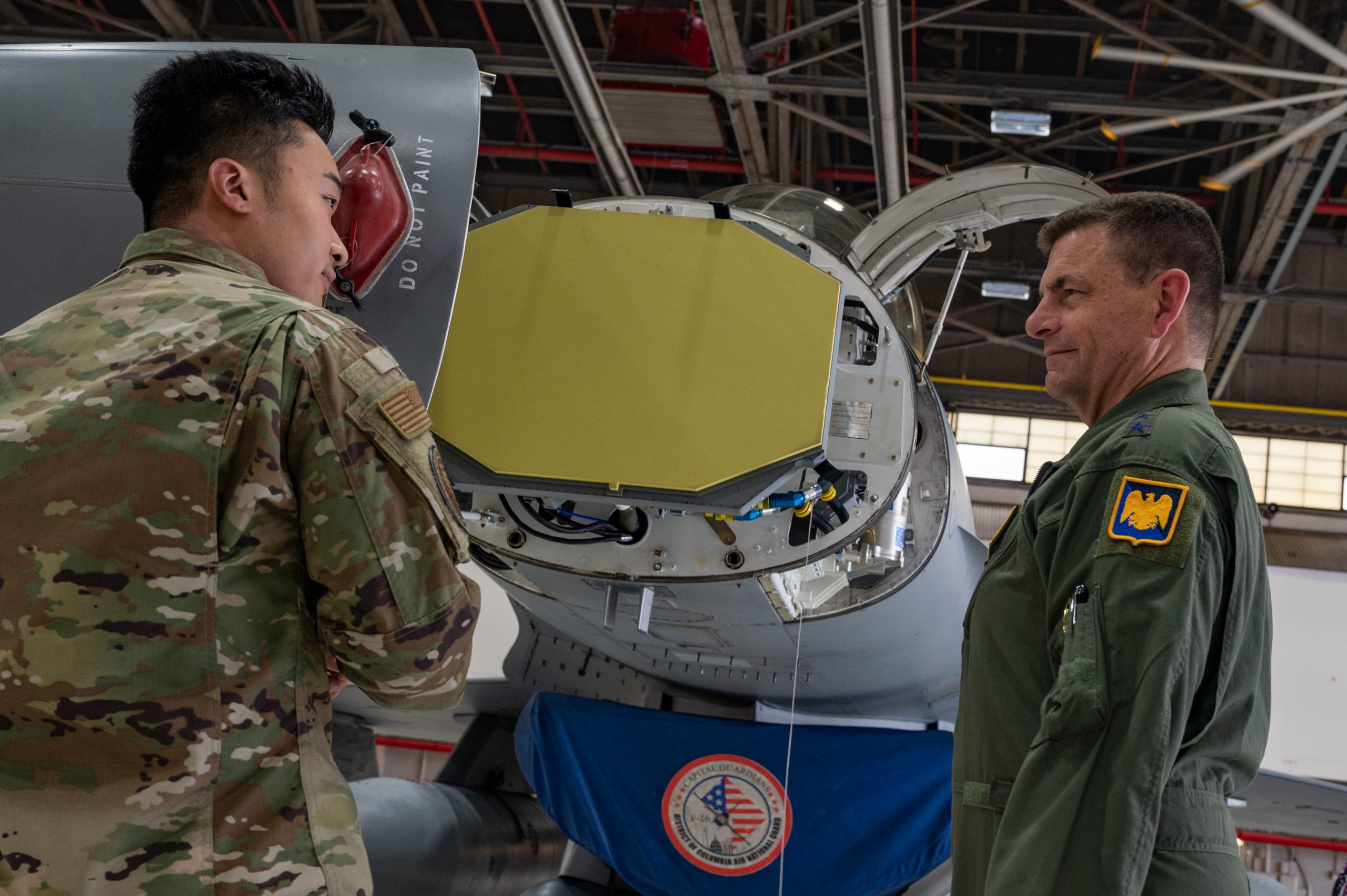
Fifth Generation Fighters
Building on Northrop Grumman’s long experience with AESA fire control radars, including the AN/APG-77 long-range, active and passive, multi-function AESA radar developed for the Lockheed Martin F-22 RAPTOR combat aircraft, the US company also provide the APG-81 AESA radar for the F-35 LIGHTNING II 5th generation stealth aircraft. The manufacturer describes the APG-81 as ‘the latest and most capable AESA in the world and acts as the cornerstone to the F-35 LIGHTNING II’s advanced sensor suite’. In addition to long-range active and passive air-to-air and air-to-ground modes, ‘the AN/APG-81 epitomises the F-35’s multi-role mission requirement showcasing the robust electronic warfare (EW) capabilities and can operate as an EW aperture utilising the AESA’s multi-function array (MFA)’, underlined the manufacturer. With a 1,676 TRMs-populated array based on GaAs technology, according to Lockheed Martin and Northrop Grumman documentation, the APG-81 is a 3rd gen tactical AESA radar supporting multiple interleaved tasks with air-to-air, passive and active modes, allowing the pilot to detect, track, identify and shoot multiple threat aircraft before the adversary detects the F-35, together with air-to-ground modes allowing for all-weather, precision targeting thanks to an ultra-high-resolution SAR (Synthetic Aperture Radar) mapping mode, which allows it to identify and engage military targets with outstanding reliability, claims Northrop Grumman.
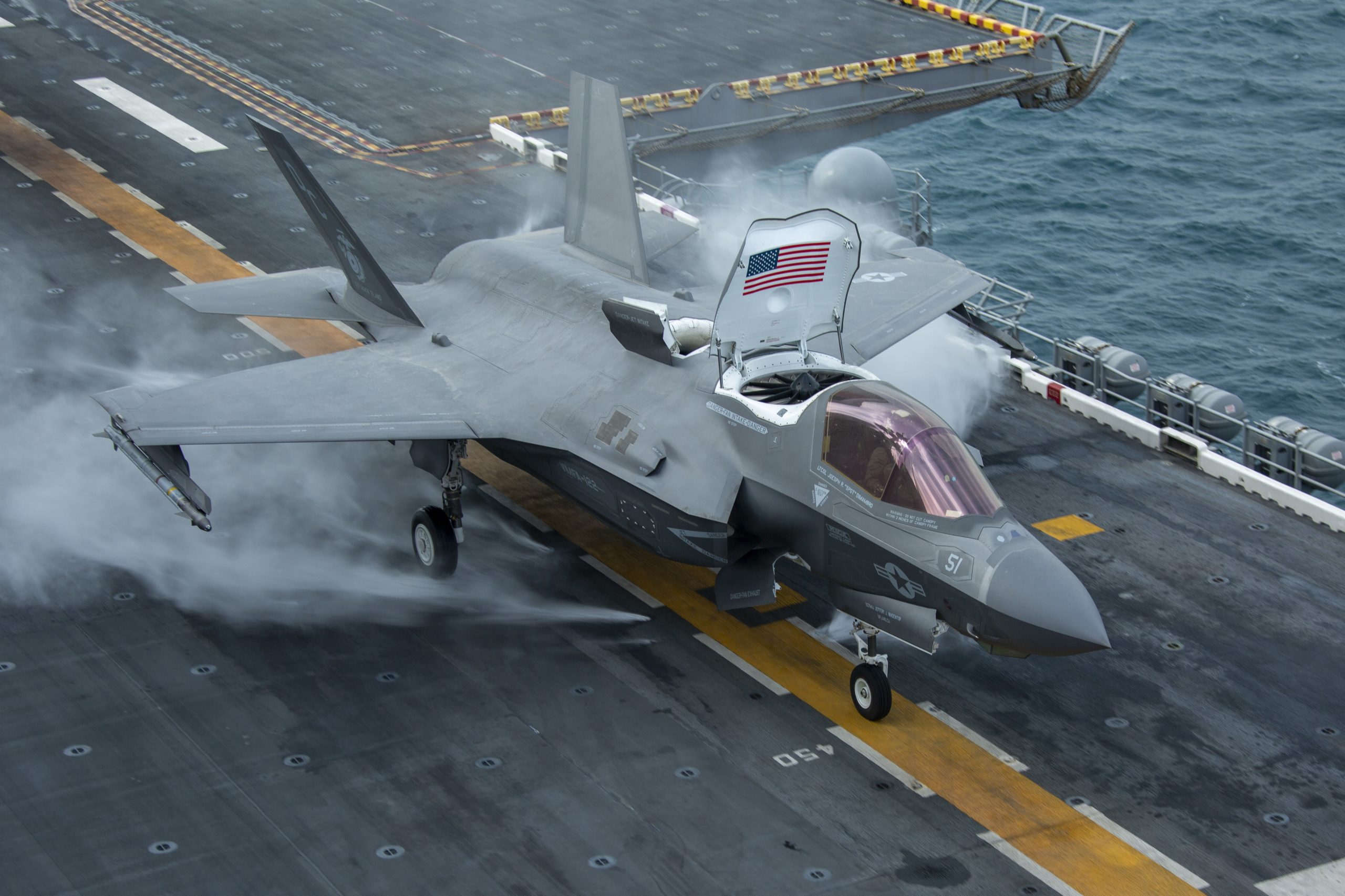
Moreover, in addition to navigation support modes, the APG-81 provides Electronic Warfare capabilities including ESM, EA, ES and advanced electronic protection and identification modes. These enable the F-35 the unparalleled capability to suppress and destroy the most advanced enemy air defences. The F-35’s APG-81 radar sensor track information are sent into the aircraft’s integrated core processor (ICP) and mission systems software fuses radar data with that sent from the Distributed Aperture Systems (DAS), the Electro-Optical Targeting System (EOTS) and the Electronic Warfare (EW) system to provide what Lockheed Martin describes as ‘unparalleled situational awareness’. The overall sensor suite, cockpit, networking and airframe/propulsion capabilities will be further enhanced through the Continuous Capability Development and Delivery (C2D2) programme which manages the development and qualification of the new Block 4 software and hardware package. The latter includes a new integrated core processor (ICP) which, although hit by technical and funding programme problems, is expected to be included since Lot 15 aircraft production in 2023 together with a panoramic cockpit display (PCD), Electronic Unit (EU) and Advanced Memory System (AMS), alongside new software and hardware testing, integration and qualification, thereby requiring more time than foreseen. With the Block 4 upgrade, the radar is expected to feature improved electronic protection in the air-to-ground and maritime modes, longer-range SAR identification especially suitable in the Suppression of Enemy Air Defence/Destruction of Enemy Air Defence (SEAD/DEAD) strategic and tactical operation, extended-range and enhanced identification alongside wide-area search in maritime environment and within-visual-range mode for offensive/defensive counter air missions.
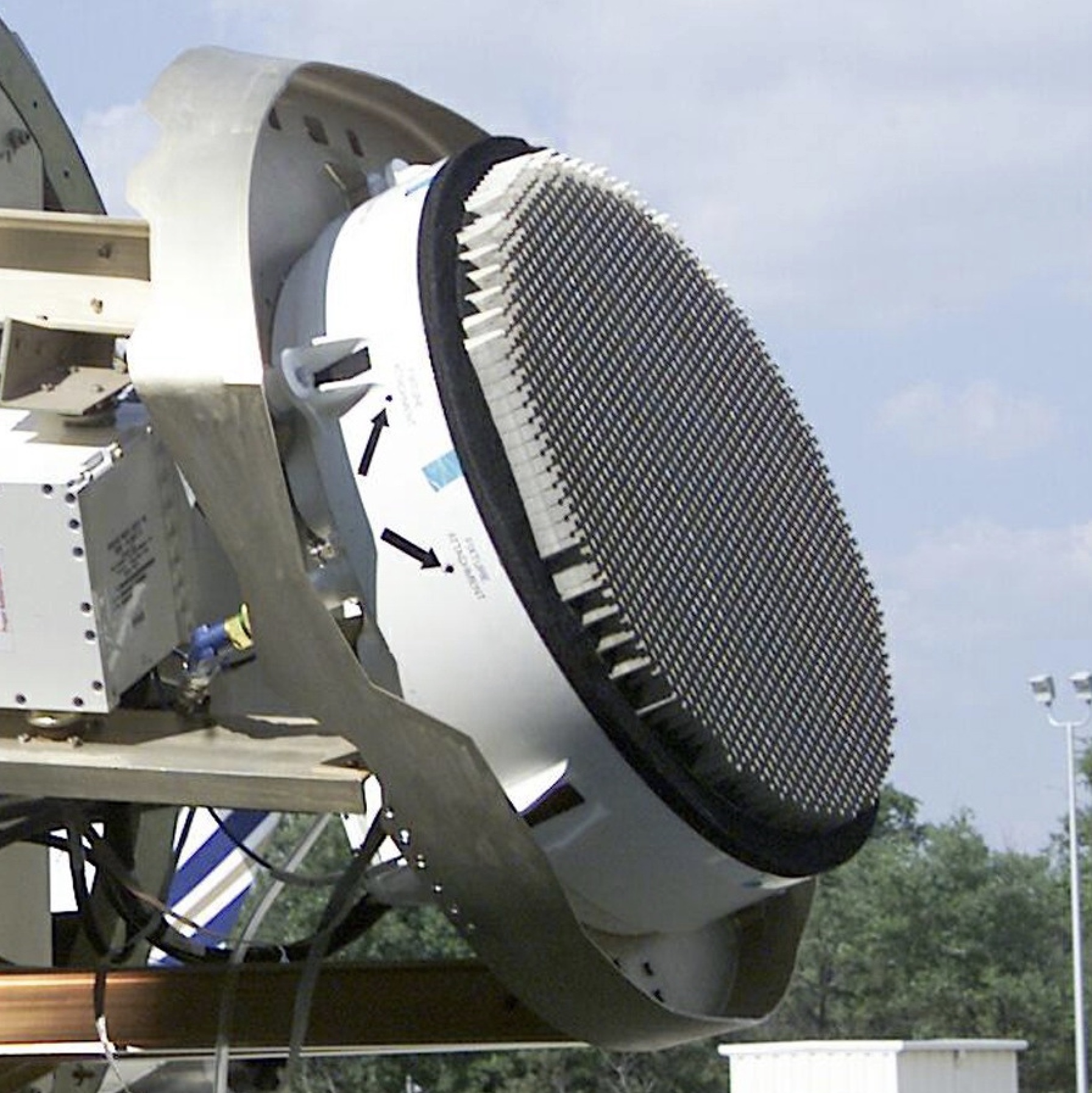
European Solutions
In December 2021, the French Presidency and Dassault Aviation announced that the United Arab Emirates had signed a contract for 80 RAFALE combat aircraft in the F.4 standard. This contract represents the first export order and has been followed by Indonesia last February for the latest standard RAFALE due to be rolled out to the French Armed Forces.

Thales AESA RBE2
The previous F3-R standard was officially declared fully operational by the French Armed Forces on March 2021. Among the enhancements introduced with the latter standard was the integration of the new MBDA long-range METEOR air-to-air missile with the Thales AESA RBE2 airborne radar, providing the French platform the air superiority it needs for beyond visual range engagements in all weather, as required for handling a wide variety of targets.
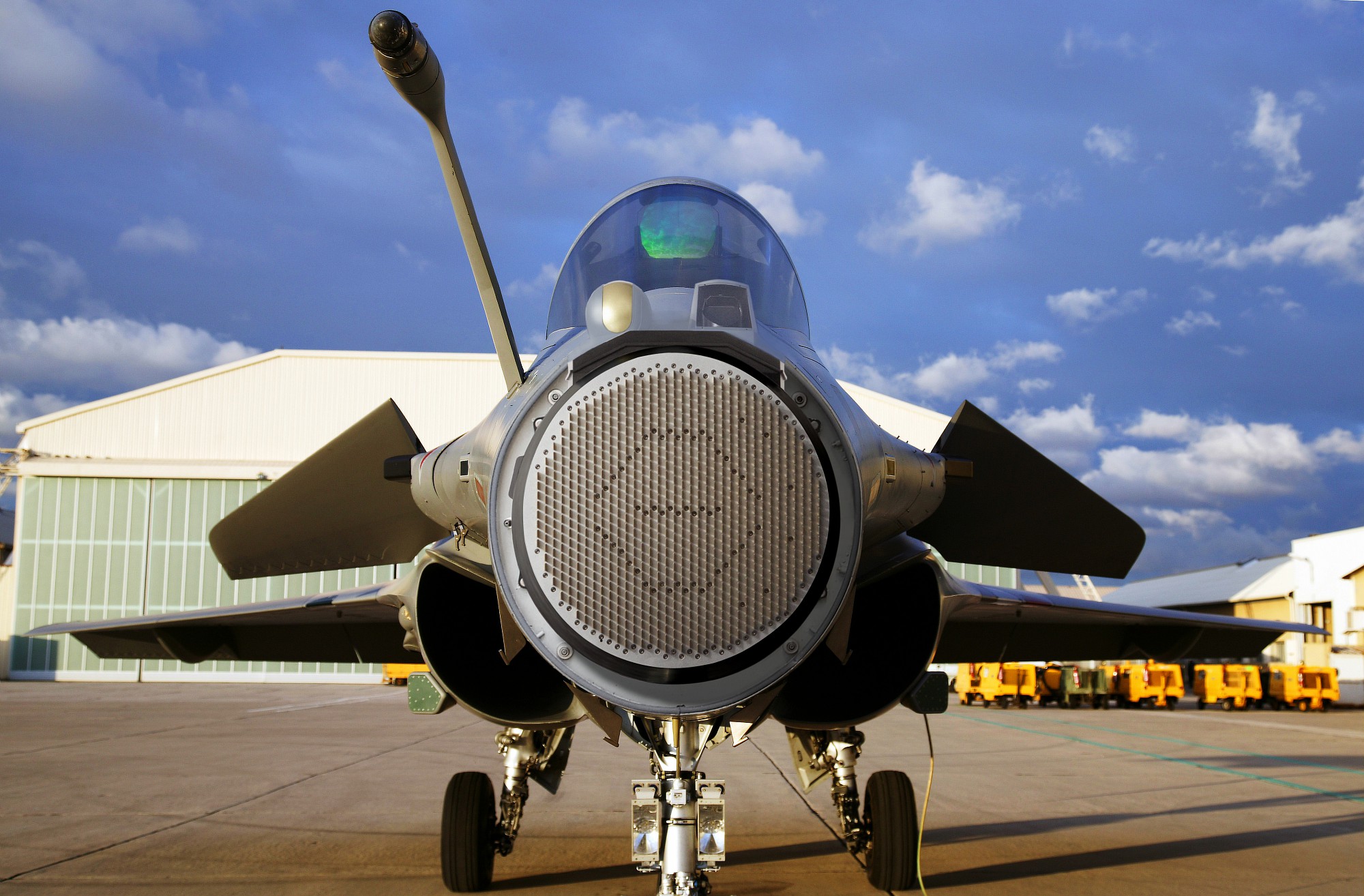
Equipping all production RAFALE aircraft delivered since mid-2013, the Thales AESA RBE2 is Europe’s first-ever AESA radar delivered to customers. According to Thales, the active electronically scanned array equipped with an undisclosed number of TRMs based on GaAs technology, offers very low-side and scattered lobes in azimuth and elevation together with very high reliability and offers multipole waveforms, coherent X-band frequency generation, excellent spectral purity, wide bandwidth and full monopulse capacities. The open architecture and fully programmable signal processor and data processor offers advanced target detection and ECCM processing, together with tracking computation and high-resolution map generation. Performing several radar modes simultaneously, the AESA RBE2 provides all-aspect look-down/look-up detection and tracking of multiple air targets for close combat and long-range interception and in jammed environment in all weather, real-time generation of 3D maps for automatic terrain following and avoidance. It also offers real-time generation of high resolution maps for navigation and targeting, detection and tracking of multiple sea targets. Key operational benefits include extended range capabilities supporting low-observable target detection and full use of new weapon systems such as the METEOR missile, higher reliability and greater waveform agility for SAR imaging and improved resistance to jamming.

In addition to the French Air Force and Navy, the new radar equips the aircraft in service or under delivery to Egypt, India, Qatar, Greece and ordered by Croatia, UAE and Indonesia. With a contract awarded by the French MoD in 2019, Dassault Aviation is leading the development of the F.4 standard which, in addition to a new generation communications and connectivity suite, new weapons integration and availability enhancements, includes upgrades to the sensor suite. The AESA RBE2 will see the introduction of two new air-to-surface modes: a ground-moving target indicator (GMTI) to detect and track moving targets over land and an ultra-high resolution SAR (UHR-SAR) mode, replacing the current HR functionality, offering superior radar image quality at very long distances. The interleaving of radar modes will be enhanced, providing the crew with even better situational awareness. Later on, the AESA radar is also expected to be enhanced to track small radar-cross section (RCS) targets, which can be identified as mini- and micro-UAVs. The weapon package will also be expanded, introducing among others, the MBDA MICA NG (Next Generation) equipped with new AESA RF and IR seekers technology. The F4 standard full package validation is planned to be completed in 2024 with first platform deliveries in 2025, while some capabilities will be available earlier. A further evolved RAFALE standard could see the focus on multi-function arrays (MFAs) based on GaN technology to be used for different purposes including detection, jamming and communications.
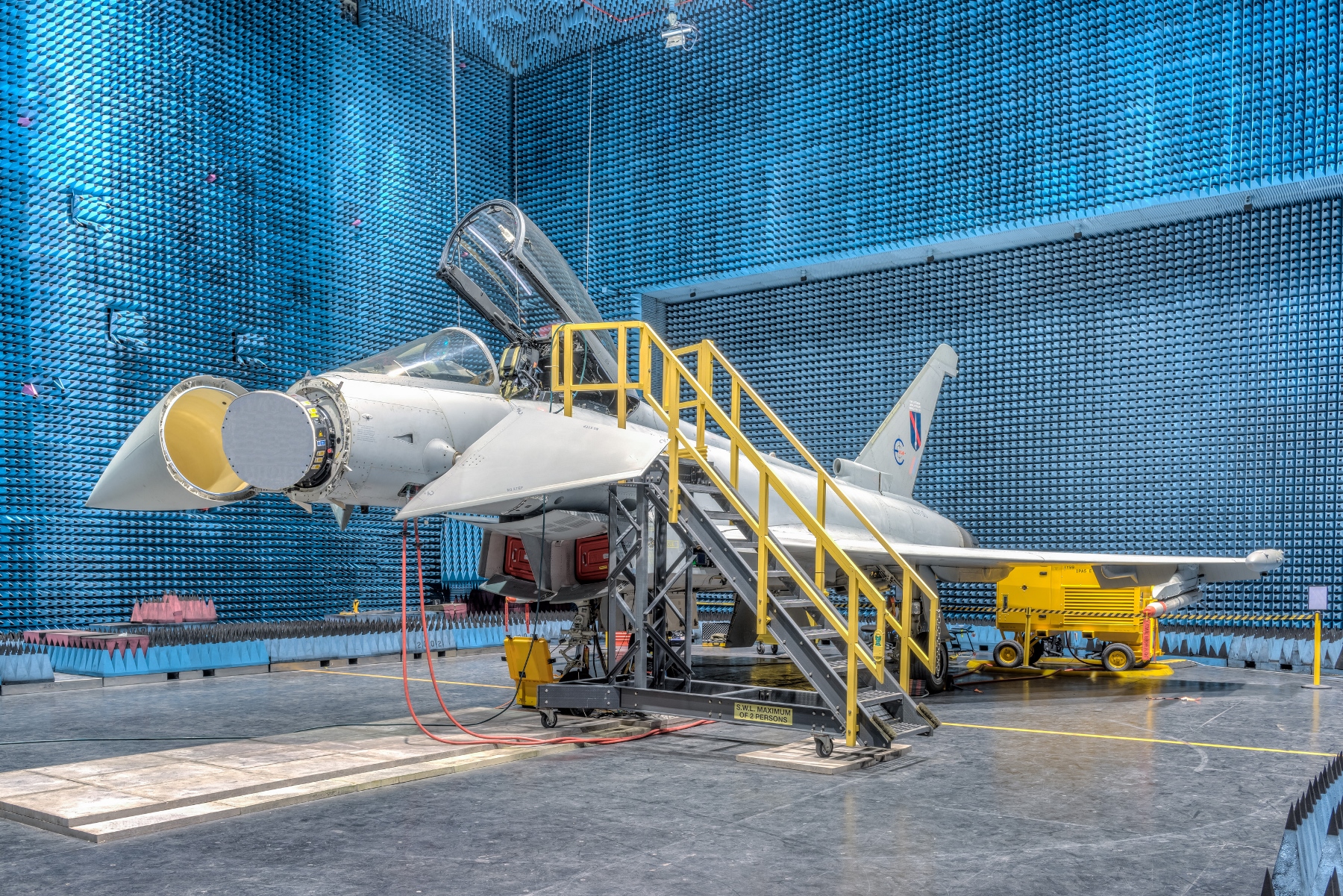
Photo: Leonardo
CAPTOR-E or ECRS Family Developments
Having equipped the Eurofighter TYPHOON with the CAPTOR-M mechanically scanned multi-mode radar provided by the EuroRADAR consortium led by Leonardo and including Hensoldt and Indra companies, the Eurofighter consortium has long recognised the integration of an AESA radar as a fundamental enabler for capability growth in both more conventional and new domains. Launched in 2010, the CAPTOR-E, also known as Radar 1+ and later known as the European Common Radar System (ECRS) Mk0, retains the ‘back-end’ of its progenitor but replaces the mechanical scanner with a new AESA antenna mounted on a double swashplate repositioner. The latter has a scan volume about 50 per cent wider than traditional fixed plate systems (with over +/-90° on either side of the boresight). The first ECRS Mk0 customer was Kuwait, which received the first two Eurofighter TYPHOON aircraft in December 2021, to be followed soon by Qatar platforms.

In July 2020, Airbus Defence and Space awarded Hensoldt a contract to develop and produce the new Mk1 version of the AESA-equipped ECRS for German and Spanish Eurofighter customers. Jointly funded by these partner nations, the programme sees the procurement of the ECRS Mk1 to equip the 38 Eurofighter TYPHOON Tranche 4 aircraft on order for the German Air Force under project ‘Quadriga’, alongside a large-scale retrofit programme for earlier aircraft from Tranche 2 and 3 plus the same radar version for the 20 Eurofighter TYPHOONs being procured for the Spanish Air Force, under a contract awarded at ILA 2022 to the Eurofighter consortium by the NATO EUROFIGHTER and TORNADO Management Agency. For the first time, Hensoldt leads a consortium with Spanish partner Indra assuming the role of radar design authority under a technology transfer agreement with Leonardo, to develop the new radar version which is to be implemented in the middle of the decade. The ECRS Mk1 answers new operational requirements of the two customers by adding, according to Hensoldt, considerable capability to the first iteration or ECRS Mk0 of the Eurofighter E-scan radar, developed and produced by the EuroRADAR consortium, which is being continuously supported by Hensoldt. While using ‘legacy’ Mk0 components, the Mk1 introduces a new fully digital multi-channel receiver and new TRMs based on GaAs technology that offer a greater frequency range and that have a larger bandwidth. Both capabilities are needed for improved agility within the frequency band, which together with new digital waveforms provide low probability of intercept (LPI) capabilities, as well as enabling the radar to have better recognition capabilities. Initially installed in the so-called ‘Step 1’ configuration, which significantly expands the existing capabilities of the Mk0, its successor will include ESM and electronic warfare capabilities including EA and ES, while target recognition and detection are also improved.

Other notable features are the ultra-high-resolution imaging SAR (UHR-SAR) imagery and ground-moving target indication through STAP processing, which are the basis of on-board artificial intelligence (AI) and threat classification accuracy, according to Hensoldt. The industrial consortium is, however, already planning for the ‘Step 2’ iteration. This is essentially a major software upgrade that will further exploit the processing capabilities inherent in the system, adding task-based management, electronic warfare as well as other advanced features, according to the company. Equipped with the new Mk1 radar – particularly in its “Step 2” variant – the TYPHOON, according to Hensoldt, will be an ideal ‘legacy’ partner to the Next Generation Fighter, being developed by France, Germany and Spain to participate in complex operations utilising the Air Combat Cloud, as well as Remote Carrier capabilities.

UK Requirements
The UK’s BAE Systems, as prime contractor and responsible for equipment design, was awarded in August 2020 a £317M contract by the Eurofighter consortium under which it is working with Leonardo’s UK arm to develop the so-called ECRS Mk2 (previously also known as Radar 2) to a standard ready for integration with TYPHOON. This programme represents a major capability enhancement for the TYPHOON, as the new multifunction array (MFA) radar introduces an EW capability, including wide-band EA functionality, in addition to more traditional radar functions, ensuring the UK retains the freedom to deliver air power wherever and whenever needed.
In September 2021, Italy joined the UK with the creation of an Industrial Joint Team (IJT). According to the recently released programme updates, the prototype radar hardware is on track to be delivered by Leonardo to BAE Systems for integration into the TYPHOON by late 2022, while first flight trials are planned for late 2023. To take the programme through to service, fresh funding has to be allocated. According to the UK Defence Equipment and Support agency, an initial operating capability covering the radar, training, infrastructure and other requirements is set for 2030 due to the necessary integration with the defensive aids sub-system that is part of the broader capability upgrade programme on TYPHOON called P4E. While commonality across the ECRS variants is being maintained in terms of interfaces with platform systems, the Mk2 radar is essentially a totally new system forward of the common power supply. It consists of the AESA antenna including a new rotating positioner mechanism, a multi-channel receiver, a multi-channel processor, the antenna auxiliary unit which hosts dedicated EW receiver and techniques generation functions, and the antenna power supply and control. The ECRS Mk2 is characterised by a new high-power MFA that, thanks to the large TYPHOON radome, is able to host a significantly greater number of TRMs in the array face than comparable AESA radars, according to Leonardo. Differently for the ECRS Mk0 and Mk1, the repositioner design for the Mk2 is a larger variant of that used successfully by Leonardo as the production solution for the Raven ES-05 on the newest GRIPEN. Among the solution benefits is the ability to both stabilise the antenna boresight and optimise the polarisation of the antenna radiation with respect to the threats being engaged. This has a number of advantages in SEAD missions, according to Leonardo, in addition to optimising maximum power on targets across the field of regard, a key feature for extended range missile guidance. The ECRS Mk2 makes use of GaN where needed to deliver a particular function, as well as GaAs in other parts of the radar system, without Leonardo providing any further technical details. While the multi-channel receiver and high-capacity multi-channel processor incorporated in the ECRS Mk2 are key to realising the performance of the MFA, providing the ability to receive greater information on both the targets and the operating environment, the dedicated EW receiver and the EA techniques generator provides the EW and EA functionalities within the ECRS Mk2.. The ECRS Mk2’s wider bandwidth required the introduction of a new nose radome by Meggitt developed in conjunction with BAE Systems and Leonardo.
Luca Peruzzi


